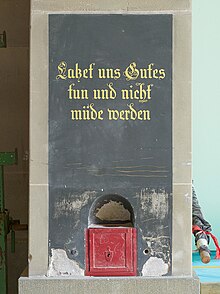Burgerspital

The Burgerspital ( Bern German : Burgerspittel (m)) was a retirement home for members of the civic community of Bern on Bubenbergplatz in the center of the city of Bern . Two old people's institutions are now operated under the name “Der Burgerspittel”.
history
The Burgerspital was the legal successor to the Great Hospital, which was founded in 1307 by the city of Bern as the Lower Hospital, was housed in the former Dominican monastery in 1528 and moved into the new building on Bubenbergplatz in 1742. In 1715 the Obere Spital (former Heiliggeistspital), founded in 1288, was merged with the Great Hospital. Since the Reformation, the lands of the Burgerspital have included St. Peter's Island with the former Cluniac priory . From 1846 until the inauguration of St. Ursula's Church in the Kirchenfeld district on September 20, 1906, Anglican services were occasionally celebrated in the Burgerspital chapel . The archives of the Burgerspital are publicly accessible in the Burgerbibliothek Bern .
Since the 1990s, the civic community of Bern has been reorganizing the Burgerspital institution, which dates back to the Middle Ages. The administration of the former monastery building and the winery on St. Petersinsel as well as the administration of the hospital's own property ("Spitaleinzieherei") were administratively separated from the Burgerspital, but not in terms of ownership. In 2009 the winery was leased to the vineyard of the city of Bern for marketing. At the same time, the Burgerspital and the Burgerheim (in the Viererfeld) were merged under the new name Der Burgerspittel and received a new logo instead of the coat of arms used since the beginning of the hospital. Due to the merger and the new naming ( Der Burgerspittel at Bahnhofplatz and Der Burgerspittel in Viererfeld ), the term “Burgerspittel” is retained, although the institution itself no longer exists in its traditional form.
After two popular resolutions, on December 17, 2008 and December 16, 2009, the building was completely renovated for the first time in 2012–2014, also with regard to its partial conversion. Since the completion of the construction work at the end of 2014, the Bernese GenerationsHouse, large parts of the burger administration (presidium, burger chancellery, financial administration, civic social center and domain administration) and the old people's facility Der Burgerspittel on Bahnhofplatz with its 35 care places have been located under the roof of the Burgerspital .
Bernese generation house
The Bernese GenerationsHouse is a public socio-cultural meeting and cultural center in the Burgerspital and is a project of the Burgergemeinde Bern . The services in the areas of advice, support, care and coexistence are provided by various independent partner organizations such as child and youth development and community work in the city of Bern, the Bern Kornhaus libraries , the Pro Senectute Region Bern or Die Dargebotene Hand . There are conference and event rooms in the attic and in the expanded basement rooms. Church services and cultural events take place regularly in the Spittelkapelle belonging to the Burgerspital.
construction
The three-story building made of Bernese sandstone with a large inner courtyard is considered to be the most beautiful baroque building in Bern. According to a project by Joseph Abeille , it was built from 1732 under the construction management of Niklaus Schiltknecht and after his death in January 1735 under that of Samuel Lutz and completed in 1742. The Latin inscription Christo in pauperibus ( something like : "Serve the Lord by serving the poor") is said to go back to Albrecht von Haller . Its biblical basis is a statement of Jesus , which is handed down in the Gospel of Matthew : "Truly I say to you, what you did to one of these my least brothers, you did it to me" (Matthew 25, 34-40).
A chapel belongs to the Burgerspital , which was moved from the northwest corner of the main building to the rear building towards the end of the 19th century. The magnificent management room with paneled walls in white and gold is remarkable.
archive
- Archives of the Burgerspital in the catalog of the Burgerspital Bern
See also
Web links
- Official website of the Bernese Generation House
- In the generation house, the encounters are mostly coincidental - portrait on Swiss radio and television SRF, September 18, 2015
- Official website of the Burgerspittel
- Official website of the Burgergemeinde Bern
- Burgerspital on the ETHorama platform
Individual evidence
- ^ History - Rebgut der Stadt Bern. Retrieved October 20, 2019 .
- ^ Civil institutions: Burgerspital. (No longer available online.) Burgergemeinde Bern, January 15, 2013, archived from the original on January 15, 2013 ; accessed on October 11, 2019 .
- ^ Website of the Burgerspittel. Retrieved October 20, 2019 .
Coordinates: 46 ° 56 ′ 53 " N , 7 ° 26 ′ 21" E ; CH1903: 600041 / 199 663




